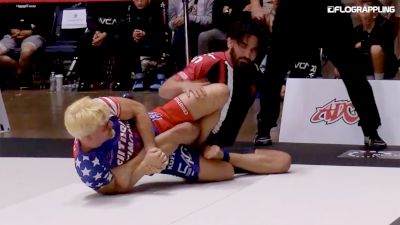Grappling's Most Dangerous Move Is Becoming More Popular
Grappling's Most Dangerous Move Is Becoming More Popular
We are seeing the kani basami show up more often in submission grappling - what is it and what should fans know?

Every exchange in submission grappling carries a certain amount of risk, but some are riskier than others. There's one move that many professionals don't even bother using in training but when you see it - it can be a fight-ender. For years we saw very few examples of it, but now we are seeing a rise that deserves noted.
The kani basami is a jumping leg entanglement entry that often leads directly to the inside heel hook. If you pull it off correctly, you have an incredible highlight reel. Even if you miss the heel hook, you are in a deep connection to the legs and have plenty of chances to work. So what's the risk? If you do the entry wrong, you can shatter an opponent's leg (or a training partner's).
While the goal in submission grappling is to apply potentially dangerous holds to their opponent and make them submit or face the physical consequences, there's an unwritten agreement - you'll have a chance to tap. Maybe in the heat of competition, there can be some pops as a move comes on quick but ultimately very few are looking to truly incapacitate their opponent - just submit them.
Any move that adds a jump into the action will be more dangerous for the simple reason that when that person is jumping (even by choice) no one is truly in control of their body weight. They lack the connection to the ground to adjust and their opponent has no reliable way to keep the situation safe. Flying armbars and triangles also bring this level of risk, though if people are injured during the execution of those it is usually the person who chose to attempt the move.
The kani basami is a little different in that you can horribly injure someone else through no fault of either party. The risk is against the knee, with the way that people jump into the side of their opponent. If they misjudge that distance or the distance changes during the jump it is shockingly easy for the leg to be buckled in by the near-entirety of that person's weight and momentum. It can end in devastating injury. There are examples we could share in this article of the move going poorly - but hopefully you can take my word for it.
This move was first made reasonably common in Kōdōkan judo and the name "kani basami" translates to a crab claw or pincers, drawn from the way the legs scissor like a crab's claw around the knees & waist. It has carried a controversial reputation for years, and has been banned in judo since a devastating injury to Japanese judo legend Yasuhiro Yamashita. He met his rival Sumio Endo in the 1980 All-Japan championships (a very prestigious event) and Endo's kani basami broke Yamashita's leg. The move was soon outlawed for it's outsized level of risk. Most gyms, even elite professional no-gi gyms like New Wave, forbid the use of the technique unless you are specifically training it under very controlled circumstances.
There are multiple variations of the kani basami, and really what most fans think of when they think of the move is likely the half kani. There's also the classic variation with the front leg all the way across the hips, not tucked in between their legs. This provides more power for the tripping action but less connection for any resulting heel hooks, and is more of a judo-friendly throw (though it is illegal in judo now).
As for entries, there's two situations that people seem to find their way into the kani basami. The first is as a single leg counter. Your opponent has already done the work of lifting your leg and weaving it between their own, really just leaving the commitment of the jump to determine the kani basami's success. The other method is often from distance, with people walking their way in and jumping both legs in together (often from a collar tie or very minor hand fighting engagement). Perhaps the most famous example of that is Garry Tonon's from ADCC 2019, one of the cleanest we have ever seen.
So why are we talking about this move? Because we are still seeing it become more common among elite grapplers. While it's illegal in many gyms, it is still legal in a lot of professional no-gi competition like ADCC to jump into any submission you want, kani basami included, and athletes looking for an edge have found good utility in this surprise attack.
Atos black belt and 2023 IBJJF brown belt no-gi world champion Luccas Lira recently has found a lot of success with the kani basami, including the one he hit at Ocean BJJ Pro on his way to +80kg gold. This sequences was good enough for him to earn Defense Soap's Submission of the Month.

- Auto
An interesting technical notes on the kani basami - notice the way that Luccas is rolling across his back here as he hits the mat. This method does create less pressure against the knee on the jump and keeps things a little safer. He's also really wedged in with that top leg before he commits to the jump - not only is this safer but it's more secure when you want to actually finish. He used a similar variation earlier this year at an ADCC Open and has become one to watch for this highlight reel technique.
